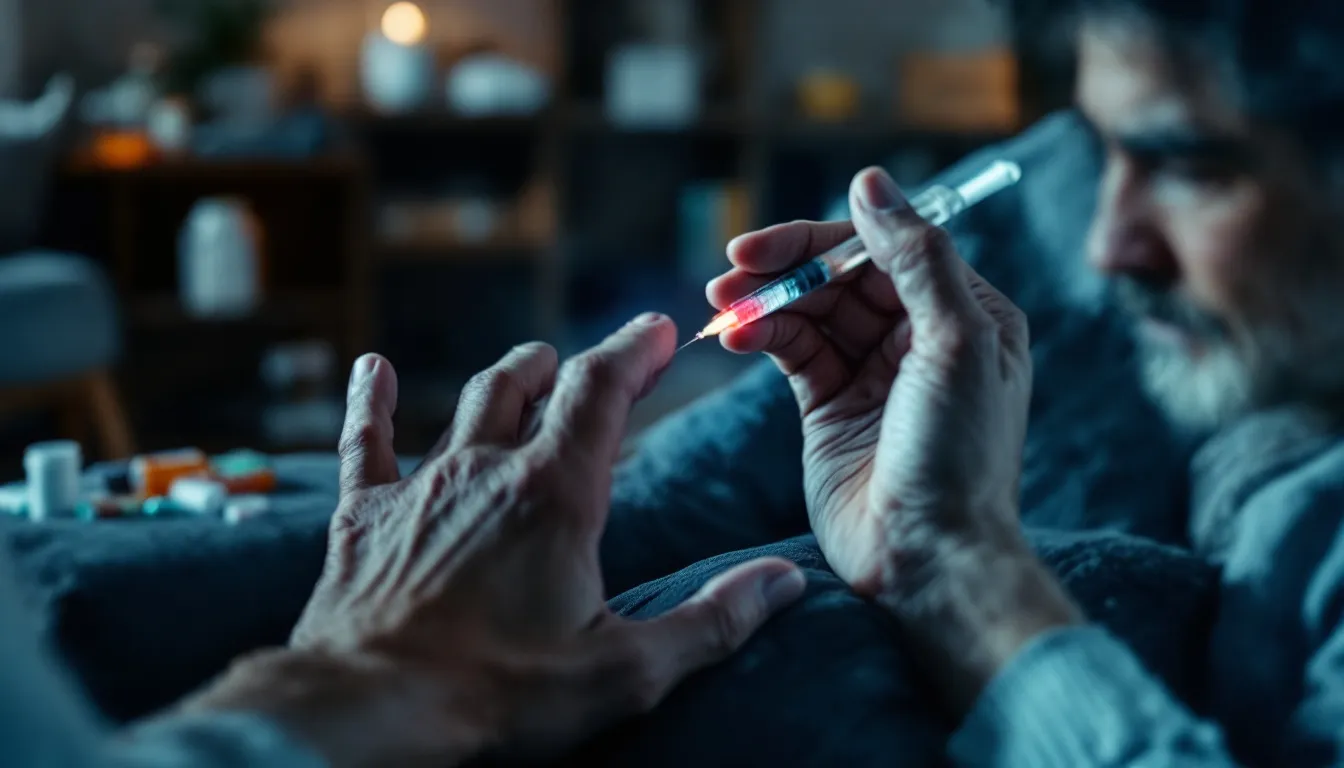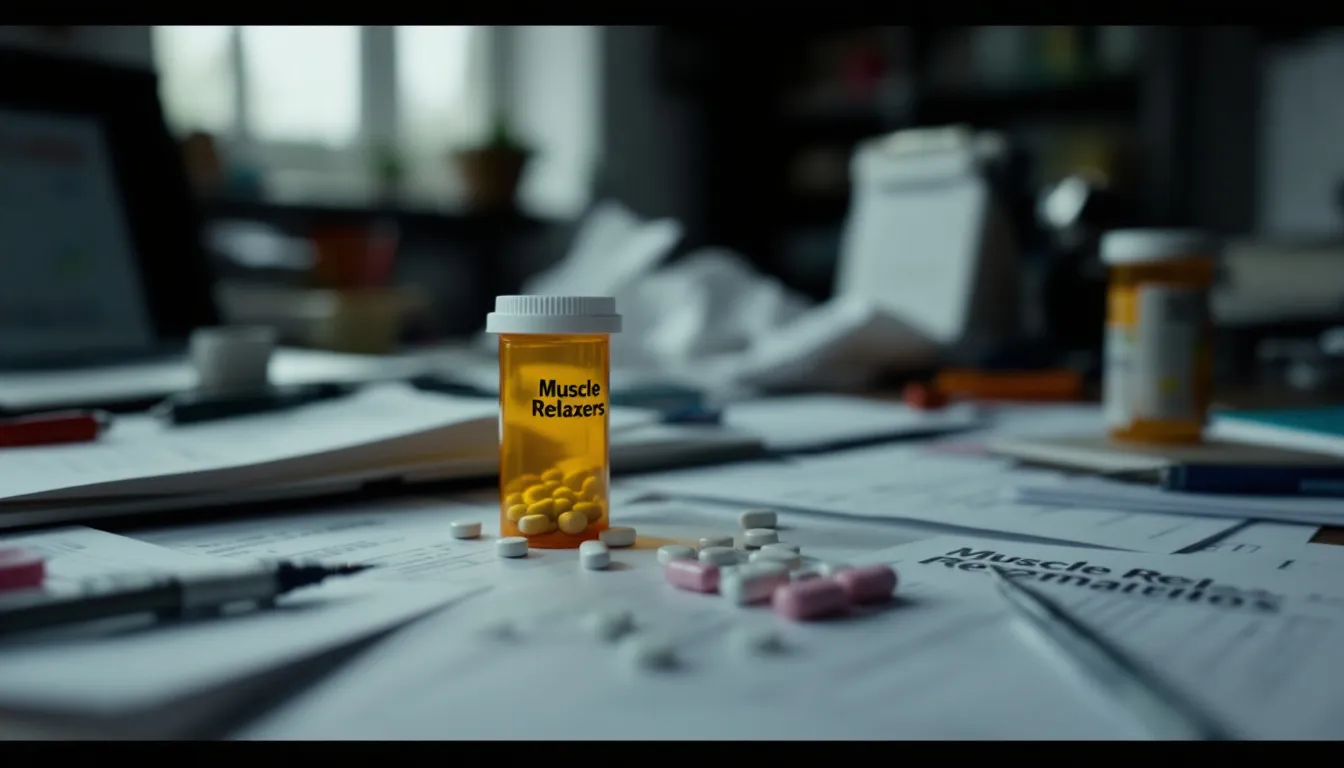

Are muscle relaxers addictive? This is a crucial question for anyone prescribed these medications for muscle pain or spasms. While muscle relaxers can provide significant relief, some types have the potential for addiction. In this article, we’ll explore the signs of addiction, associated risks, and treatment options to help you use these medications safely.
Muscle relaxers, categorized into antispasmodics and antispastics, are used to treat muscle spasms and pain but can be addictive.
Certain muscle relaxers like diazepam and carisoprodol have a higher potential for addiction, with misuse leading to serious health risks including overdose.
Effective treatment for muscle relaxer addiction includes professional counseling, behavioral therapies, support groups, and medically supervised detoxification.

Muscle relaxers are medications designed to alleviate muscle spasms and tightness, providing relief from pain. They are commonly prescribed for conditions such as spasm-related back pain, multiple sclerosis, cerebral palsy, and spinal cord injuries. These medications come in various forms, including tablets, capsules, liquids, and injections, making them versatile for different treatment needs.
Knowing the different types of muscle relaxers and how they work enables users to make better decisions about their use. This understanding benefits those who depend on these medications for managing pain and muscle spasms.
Muscle relaxers are primarily classified into two main categories: antispasmodics and antispastics. Antispasmodics work by reducing muscle spasms through the central nervous system by inhibiting neuron transmission, while antispastics affect skeletal muscles and the spinal cord to help alleviate muscle tightness and spasms.
Examples of commonly prescribed muscle relaxers include baclofen, diazepam, and tizanidine. Some prescription muscle relaxers, such as tizanidine, cyclobenzaprine, carisoprodol, and diazepam, belong to both antispasmodic and antispastic groups, making them versatile in treating various skeletal muscle relaxant-related issues.
Muscle relaxants mainly act on the central nervous system depressants to reduce muscle tightness and spasms. They target the spinal cord and brain to facilitate muscle movements, thereby decreasing the nerve impulses sent to voluntary muscles.
This action helps in relieving muscle spasms and providing muscle pain relief, making these medications effective to treat muscle spasms and conditions involving musculoskeletal pain and other related disorders.

The potential for addiction to muscle relaxers is a serious concern. Muscle relaxer addiction is characterized by compulsive drug-seeking behavior, increased tolerance, and continued usage despite adverse consequences. Physical dependence refers to the body’s adaptation to the substance, while addiction encompasses a mental dependence that drives compulsive use.
Not all muscle relaxers are equally addictive. Some, such as diazepam and carisoprodol, have a high addiction potential, while others like methocarbamol are not considered addictive. Misuse of muscle relaxers can lead to addiction, serious side effects, and even potential death.
Certain muscle relaxers are more prone to abuse due to their sedative properties. Common muscle relaxers known for their addiction potential include carisoprodol and diazepam. Soma, in particular, is frequently misused because it can produce euphoria, making it one of the most addictive muscle relaxers.
The abuse of these muscle relaxers and prescription drugs can lead to serious health risks and dependence, highlighting the importance of using these medications strictly as prescribed.
Addiction to muscle relaxers shows both physical and psychological symptoms. Physically, one might experience increased tolerance, cravings, excessive sedation, dizziness, impaired coordination, breathing difficulties, and dilated pupils. Many individuals find themselves addicted to muscle relaxers, which can complicate recovery.
Psychological signs include constant preoccupation with the drug, irritability when not using, difficulty concentrating, mood swings, confusion, memory issues, insomnia, and paranoia. Using muscle relaxers like cyclobenzaprine longer than recommended is also indicative of addiction.

The misuse of muscle relaxers can lead to severe risks and complications. One major risk is overdose, which can result in:
changes in consciousness
hallucinations
seizures
even death
People may misuse muscle relaxers for their euphoric effects, increasing the likelihood of these serious consequences.
Mixing muscle relaxers with alcohol or other drugs can amplify side effects and pose a significant risk of severe drowsiness, low blood pressure, and memory issues. This dangerous combination can also lead to harmful effects, including overdose.
Long-term use of muscle relaxers can lead to increased tolerance and physical dependence, necessitating higher doses for the same effect. This can result in organ damage, heart issues, anxiety, depression, and overdose.

Recovering from muscle relaxer addiction is challenging but possible with the right support and treatment programs. There are several treatment options available. These include professional counseling, cognitive-behavioral therapy, support groups, and psychotherapy. Each person’s journey to recovery is unique, requiring individualized approaches to address their specific needs.
Professional help is vital for those grappling with muscle relaxer dependency. Attempting to overcome addiction alone can result in severe consequences, underscoring the need for professional intervention. The next sections outline specific treatment options.
Behavioral therapies are key in treating muscle relaxer addiction. Cognitive-behavioral therapy, for instance, helps alter thinking patterns and manage stress, which are essential for overcoming addiction.
Counseling methods like motivational enhancement therapy are also effective, aiding individuals in developing healthy coping strategies and staying committed to recovery.
Support groups provide an environment of shared experiences and mutual support, critical for recovery. They foster a sense of community, connecting individuals facing similar challenges on their path to sobriety.
Participants gain from sharing their experiences and receiving encouragement, which strengthens their resolve to stay sober. Peer support provides emotional stability and motivation, crucial for overcoming addiction.
Medical detoxification is crucial for treating muscle relaxer addiction. It entails medically supervised withdrawal to safely eliminate muscle relaxers from the body, ensuring effective management of withdrawal symptoms.
Medically supervised withdrawal minimizes the risks associated with detoxification, ensuring a safe and controlled process. This method safely removes muscle relaxers from the system, reducing the likelihood of severe withdrawal symptoms.

Preventing muscle relaxer addiction starts with responsible use. Muscle relaxers are often prescribed for short-term use due to their potential for dependence. It is essential to never exceed the prescribed dosage and to follow the guidance of healthcare providers.
Consulting with a healthcare provider about the risks associated with muscle relaxers is especially important for those with a history of substance use disorder. Extended use may result in greater tolerance. It can also lead to physical dependence, highlighting the importance of careful monitoring.
Adhering to the prescribed dosage helps prevent long-term issues related to muscle relaxer use. Monitoring for signs of dependence and seeking early intervention can also avert the development of addiction.
Understanding muscle relaxers, their potential for addiction, and the risks involved is crucial for anyone using these medications. Muscle relaxers are effective for treating muscle spasms and pain, but their misuse can lead to serious health issues, including addiction, overdose, and long-term complications.
Recovery from muscle relaxer addiction is possible with the right support and treatment. Through behavioral therapies, support groups, medical detoxification, and preventive measures, individuals can overcome addiction and lead healthier lives. Awareness, responsible use, and seeking professional help are key to managing and preventing muscle relaxer addiction.

At Sullivan Recovery, as an in-network provider we work with most insurance plans, such as:
And More
If you or a loved one are struggling with mental health challenges or substance abuse, reach out to Sullivan Recovery today. Our team of compassionate professionals is here to support your journey towards lasting well-being. Give us a call at 949-836-7180.
Certain muscle relaxers, particularly carisoprodol and diazepam, can be addictive. It’s crucial to use them under medical supervision to mitigate the risks of dependency.
Muscle relaxer addiction can be indicated by increased tolerance, cravings, excessive sedation, irritability, mood changes, and difficulty concentrating. Recognizing these signs early can help in seeking timely intervention.
Mixing muscle relaxers with alcohol significantly increases the risk of severe drowsiness, low blood pressure, memory issues, and overdose. It is essential to avoid this combination to ensure your safety.
Muscle relaxer addiction can be effectively treated through professional counseling, cognitive-behavioral therapy, support groups, and medical detoxification. Engaging in these treatments can lead to successful recovery and improved well-being.
To prevent muscle relaxer addiction, it’s essential to use these medications responsibly by adhering to prescribed dosages, consulting with healthcare providers, and regularly monitoring for any signs of dependence. Taking proactive steps will help safeguard against potential addiction.